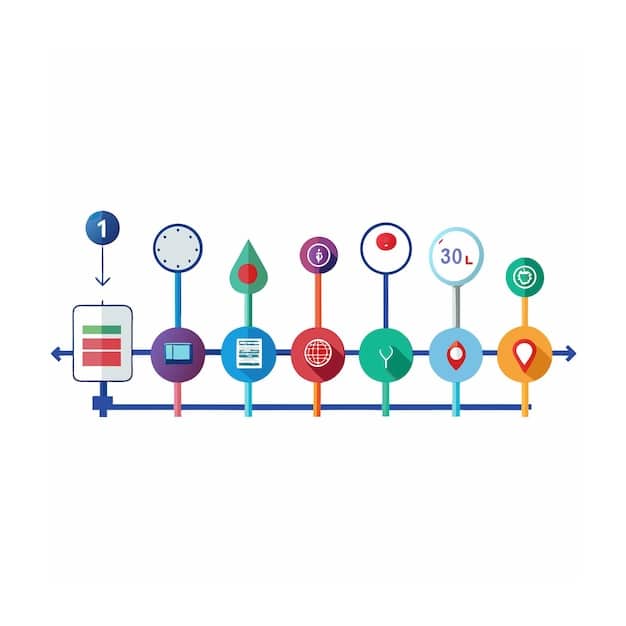Data-Driven E-commerce: Supercharge Your Marketing with Analytics

Data-Driven E-commerce: Using Analytics to Improve Your Digital Marketing Strategy involves leveraging data insights from customer behavior, sales trends, and marketing campaign performance to make informed decisions that optimize marketing efforts and boost e-commerce success.
In the dynamic realm of e-commerce, staying ahead requires more than just intuition; it demands a strategic approach fueled by data. Data-Driven E-commerce: Using Analytics to Improve Your Digital Marketing Strategy is the key to unlocking unprecedented growth and creating personalized customer experiences.
Understanding the Core of Data-Driven E-commerce
Data-driven e-commerce is more than a buzzword; it’s a fundamental shift in how online businesses operate. It involves collecting, analyzing, and interpreting data to inform marketing strategies, improve customer experiences, and ultimately drive sales.
The Importance of Data Collection
Effective data collection is the foundation of any successful data-driven e-commerce strategy. This involves gathering data from various sources, including website analytics, customer relationship management (CRM) systems, social media platforms, and marketing automation tools.
Key Data Points to Track
Identify and track key data points such as website traffic, bounce rates, conversion rates, customer demographics, purchase history, and engagement metrics. These data points provide valuable insights into customer behavior and marketing performance.
- Track website traffic sources to understand where your customers are coming from.
- Monitor conversion rates to identify areas for improvement in the sales funnel.
- Analyze customer demographics to tailor marketing messages to specific segments.
- Review purchase history to identify product trends and customer preferences.
By understanding the core principles of data-driven e-commerce and focusing on effective data collection, businesses can lay the foundation for a successful digital marketing strategy.

Leveraging Web Analytics for E-commerce Insights
Web analytics tools are essential for understanding how visitors interact with your e-commerce website. These tools provide valuable data on user behavior, traffic sources, and conversion funnels, enabling you to optimize your website for better performance.
Google Analytics for E-commerce
Google Analytics is a powerful and free tool that offers a wealth of data on your website’s performance. It allows you to track key metrics such as page views, bounce rates, session durations, and conversion rates.
Setting Up E-commerce Tracking
To get the most out of Google Analytics, it’s crucial to set up e-commerce tracking. This feature allows you to track transactions, revenue, and product performance, providing valuable insights into your sales data.
- Enable e-commerce tracking in Google Analytics to monitor sales performance.
- Create custom dashboards to visualize key metrics and track progress.
- Use segmentation to analyze user behavior based on demographics, location, and traffic source.
- Set up goals to track specific actions, such as form submissions and product purchases.
By leveraging web analytics tools like Google Analytics, e-commerce businesses can gain valuable insights into user behavior and optimize their websites for better performance.
Creating Personalized Customer Experiences with Data
Personalization is a key driver of customer loyalty and increased sales in e-commerce. By using data to understand individual customer preferences and behaviors, businesses can create personalized experiences that resonate with their audience.
Segmenting Your Customer Base
Customer segmentation involves dividing your customer base into distinct groups based on shared characteristics such as demographics, purchase history, and browsing behavior. This allows you to tailor marketing messages and product recommendations to each segment.
Personalized Product Recommendations
Using data on past purchases and browsing history, you can provide personalized product recommendations that are relevant to each customer. This can increase the likelihood of a purchase and improve customer satisfaction.
- Use customer segmentation to tailor marketing messages to specific groups.
- Implement personalized product recommendations based on past purchases and browsing history.
- Send targeted email campaigns with personalized offers and promotions.
- Create personalized landing pages with content tailored to individual customer interests.
By using data to create personalized customer experiences, e-commerce businesses can foster loyalty, increase sales, and stand out in a competitive market.

Optimizing Marketing Campaigns with A/B Testing
A/B testing, also known as split testing, is a powerful method for optimizing marketing campaigns. It involves creating two versions of a marketing element, such as an email subject line or a landing page, and testing which version performs better with your audience.
Testing Email Subject Lines
Email subject lines are crucial for getting your emails opened. A/B testing different subject lines can help you identify which ones generate the highest open rates.
Optimizing Landing Pages
Landing pages are designed to convert visitors into customers. A/B testing different elements of your landing pages, such as headlines, images, and call-to-action buttons, can help you optimize them for higher conversion rates.
- Test different email subject lines to improve open rates.
- A/B test landing page headlines and images to increase engagement.
- Experiment with different call-to-action buttons to drive conversions.
- Use A/B testing to optimize ad copy and bidding strategies.
By using A/B testing to optimize marketing campaigns, e-commerce businesses can improve their ROI and drive better results.
Analyzing Customer Feedback to Improve Products and Services
Customer feedback is a goldmine of information that can be used to improve products, services, and the overall customer experience. By actively soliciting and analyzing customer feedback, businesses can gain valuable insights into what customers like and dislike.
Collecting Customer Reviews
Encourage customers to leave reviews of your products and services. These reviews provide valuable social proof and can influence purchasing decisions.
Using Surveys and Feedback Forms
Surveys and feedback forms are great ways to gather specific information from your customers. Use them to ask about their experiences with your products, services, and customer support.
- Encourage customers to leave reviews to build social proof.
- Use surveys to gather specific feedback on products and services.
- Analyze customer feedback to identify areas for improvement.
- Implement changes based on customer feedback to enhance the customer experience.
By actively soliciting and analyzing customer feedback, e-commerce businesses can continuously improve their offerings and create a more customer-centric experience.
Predictive Analytics for E-commerce Forecasting
Predictive analytics uses historical data to forecast future trends and behaviors. In e-commerce, predictive analytics can be used to forecast sales, anticipate customer churn, and identify potential product trends.
Forecasting Sales Trends
Using historical sales data, you can forecast future sales trends and adjust your inventory and marketing efforts accordingly. This helps you avoid stockouts and maximize revenue.
Anticipating Customer Churn
Predictive analytics can help you identify customers who are likely to churn, allowing you to proactively engage them and reduce customer attrition.
- Use predictive analytics to forecast sales trends and optimize inventory levels.
- Identify customers at risk of churning and engage them with targeted offers.
- Predict product trends to inform product development and marketing strategies.
- Use predictive analytics to personalize marketing messages and product recommendations.
By leveraging predictive analytics, e-commerce businesses can make data-driven decisions that improve their bottom line and enhance the customer experience.
| Key Point | Brief Description |
|---|---|
| 📊 Data Collection | Gather data from website, CRM, and social media. |
| 📈 Web Analytics | Use tools like Google Analytics for user insights. |
| 👤 Personalization | Create tailored experiences with customer data. |
| 🧪 A/B Testing | Optimize campaigns by testing different versions. |
FAQ: Data-Driven E-commerce
▼
Data-driven e-commerce involves using data to inform marketing strategies and improve customer experiences, leading to increased sales and customer loyalty.
▼
Data collection is crucial for understanding customer behavior, identifying trends, and making informed decisions about marketing and product development.
▼
Web analytics tools provide insights into user behavior, traffic sources, and conversion funnels, helping you optimize your website for better performance.
▼
A/B testing involves creating two versions of a marketing element and testing which one performs better, helping you optimize campaigns and improve ROI.
▼
Personalization enhances customer experience by tailoring marketing messages and product recommendations to individual preferences, fostering loyalty and driving sales.
Conclusion
In conclusion, embracing a data-driven approach is essential for e-commerce businesses looking to thrive in today’s competitive digital landscape. By leveraging data, optimizing marketing campaigns, and personalizing customer experiences, businesses can unlock unprecedented growth and achieve long-term success.





